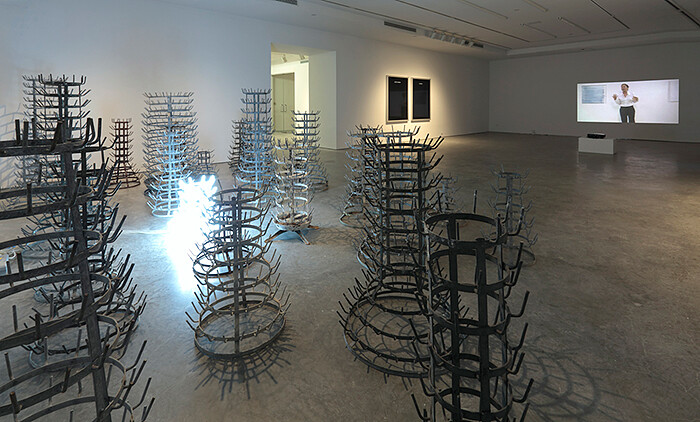The term “problem play” originated when nineteenth-century theater made a realist turn, saddling characters and stories with the cause célèbres of the day. In simplest form, drama gave way to soapbox sermons and moral absolutism. The prevalence of such mediocrity may account for why the problem play’s most artful contributor, Henrik Ibsen, went so far as to profess no interest in feminism at a dinner lauding his support of the cause.(1)
Compounding the problem as subject is the problem of classification—Shakespeare scholar Frederick S. Boas has repurposed the term to designate works that toe the Aristotelian line and thus compel us to “move along dim untrodden paths.”(2) Rather than settle on a catchall of convenient imprecision, like “tragicomedy” or “dark humor,” Boas retains “problem play” wholesale, implying that the form’s problematic eluding of traditional genres is key to its critical operation.
The eponymous group exhibition on view at Leo Koenig Inc. brings both definitions to bear on the generational inheritance of its participating artists. The audience enters the gallery through the back door, as it were, greeted by contemporary annotations of ur-texts. Bethan Huws’s two display boards, Ladies and Gentlemen (2006), educe gendered scripts from the assisted readymade, contingently troubling her nearby homage to Duchamp: twenty-eight bottle racks encircling their Platonic form, fashioned in white neon and excess metaphor (Forest [Floresta], 2007). Ideality strips down to naked ambition in Jonathan Monk’s text painting, This Painting Should Ideally Be Hung to The Left of an Ed Ruscha (2004), which ironizes a mode of tactical fame-mongering that (thanks to the exhibition curators) it also successfully performs. Describing the accompanying Ruscha would undermine the total arbitrariness of the choice; Monk has made a similar painting addressed to LeWitt, and, in each case, artistic brand takes precedence over specific form.
“Problem Play” deftly girds art-historical links with linguistic and thematic ones. Monk’s aspiration to “be hung” adjoins Andrea Fraser’s video installation Kunst muße hängen [Art Must Hang] (2001), named after Kippenberger’s famous imperative to the artist, whose aluminum “smiley” disc kept falling off the wall at the Paris Bar in Berlin. In the second gallery, artists begin from the aftermath. Lara Favaretto has cast a cube of black confetti, for example, that suggests a postpartum Minimalism by way of trash compactor (Absolutely No Donations, 2009). While serving as a car accident photographer for the Swiss police force, in the late twentieth century, Arnold Odermatt generated a personal stock of unpeopled images, which naturalize disastrous encounters between landscape and automobile, as if compensating for the losses of absent protagonists.
Beyond these contestations of legacy and genre, the exhibition also engages the problem play’s social angle, most pointedly in the work of Ken Lum. The Canadian artist’s “Shopkeeper Sign Series” (2000–9) interpolates business owners into the movable type of their signage, exposing subjectivities frequently incommensurate with their company’s national and ethnic claims. Such juxtapositions can tend towards superficially ironized face-offs, though Shirley’s Bakery (2001), on view at Koenig, achieves both subtlety and pathos through limited means. Offsetting the bakery’s promise of bread “Oven Fresh Daily,” the movable type announces the shop’s one-day closure in memory of its proprietress. The irruption of death widens the gap between lived and capitalist time, rendering explicit a fundamental problem with which Lum’s exhibition mates, on dim paths through known histories, thoughtfully contend.
(1). Richard Hornby, “The Social Problem Play.” The Hudson Review 51.4 (1999), pp. 751–58. JSTOR. Web, accessed Jan. 2, 2013.
(2). Frederick S. Boas, Shakespeare and His Predecessors (New York: C. Scribner‘s Sons, 1900), p. 345.







